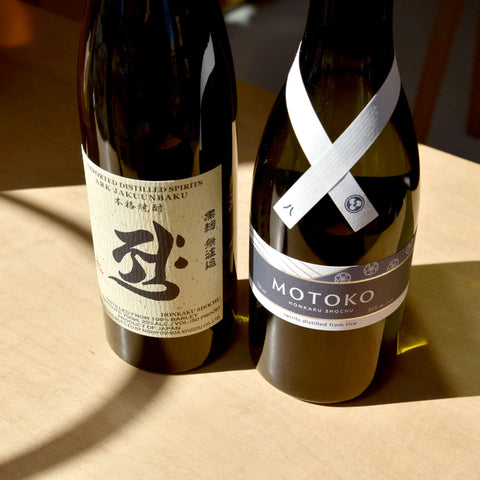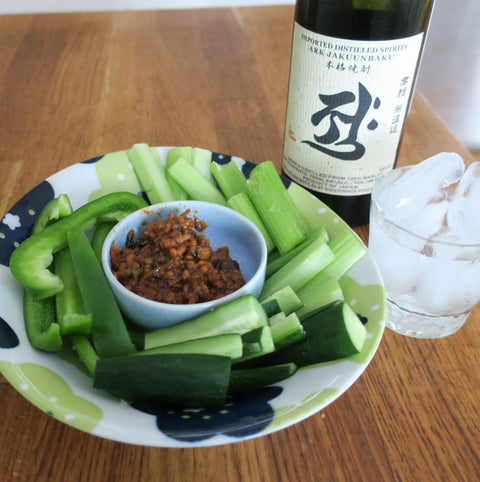 Sake Gumi is our monthly sake subscription service with 250 members throughout the country. Join today!
Sake Gumi is our monthly sake subscription service with 250 members throughout the country. Join today!
As a beekeeper, I think about female-led organizations often. In particular, I find inspiration in the queen bees of my hives, leading their workers into the seasons. Although she is at the helm of the operation, she is in constant communication with her workers, and depends on them to keep the gears turning in the hive. Each fluctuation in temperature, smell, and light is sensed acutely by the queen. Depending on these factors, she may speed up or slow down egg production, ultimately controlling the daily activities of her workers.
The queen bee's role is not unlike the toji or owners of kuras (breweries) across Japan; when I encounter breweries that are female-led, the metaphor of the hive is ever more vivid and appropriate. This month, I introduce three queen bees of the sake world: Yuri Hayashi of Aizu Chujo, Saori Kobari of Daitengu, and Akiko Hakuto of Hakuto Brewery.
Currently, around 3% of sake breweries are led by women. And although I am noticing more women in the industry since starting Sake Gumi six years ago, this is still a dismal number. Traditionally, sake-making has been thought of as "man's work" – physically intense with living conditions that evoke visions of a boy's locker room. While this is an image that is still relevant when looking at the history of sake-making, most breweries have stepped into the future. Utilizing modern technology to help with back-breaking labor and temperature control, the "romantic" notion of traveling toji trudging through the snow, or kurabito in butt-cheek baring fundoshi is something many breweries have moved past.
It's taken the rest of society to let go of some of these images, but Kobari seems optimistic. "I think that the spirit of gender equality has permeated socially," says Kobari, and adds, "Mechanization has reduced the amount of physical labor." Hakuto also notes that although sake-making used to be seasonal work, nowadays many breweries offer year-round employment, making it a more attractive option for everyone. Hakuto, who entered the sake world as a food importer and wholesale retailer, emphasizes that the industry is also not all about sake production and there are inroads for all types of people. For Yuri Hayashi, it was growing up and seeing her mother become the toji that inspired her to do the same.
Queen bees are successful for the same reasons that these women have cited as advantages to being a Female Frontrunner in sake-making: intuition and communication. When asked what advantage women have in the sake world, Hakuto replied, "Women notice small changes, and can provide detailed care in mash management and koji-making." Kobari adds, "Women have a sense of kinship and feel free to share information with other female toji and breweries."
Thank you for joining us for the sixth annual Female Frontrunners Sake Gumi celebration! Enjoy these sakes and discover your inner queen!
Yoko, Co-Founder of Umami Mart and Kikizakeshi
+++
 Aizu Chujo Namachozo Junmai
Aizu Chujo Namachozo Junmai
Tsurunoe Shuzo (Fukushima, Japan)
Seimaibuai: 60% Gohyaku Mangoku, SMV: +2, Acidity: 1.5
Yuri Hayashi is the toji at her family’s brewery, succeeding her mother, who also acted as toji. As a child, she watched the inner workings of the brewery, and later went to the Tokyo University of Agriculture to study brewing. She cites tasting freshly pressed sake as one of the most thrilling (and nerve-wracking) experiences of being a toji. Drink this mineral-forward junmai chilled to enjoy its light, refreshing flavor. Take in aromas of brown rice and yogurt, and savor its crisp acidity alongside light dishes like tofu, edamame, or an egg dish.
Read the full interview with Yuri Hayashi here.

The Hayashi family including Yuri and Keiko of Tsurunoe Shuzo
 Exterior of Tsurunoe Shuzo
Exterior of Tsurunoe Shuzo
 Daitengu Junmai
Daitengu Junmai
Daitengu Sake Brewery (Fukushima, Japan)
Seimaibuai: 60% Yume No Kaori, SMV: +5, Acidity: 1.7
As a child, Toji Saori Kobari was inspired to keep the family brewery running by watching festival-goers in her town drink Daitengu sake. She is the brewery’s fifth generation toji and uses traditional methods such as funashibori (vat press) and brews in small lots. Because of this she says, “The taste will change a little depending on the year and tank, like wine.” Notice aromas of uncooked rice, and nuts and take in flavors of caramel, honey, and a hint of konbu, all with a dry ending. Kobari also suggests aging this sake to deepen the caramel aroma. Try pairing this sake at room temperature with nimono (winter root vegetable) or warm chicken soup. Read the full interview with Soari Kobari here.

Saori Kobari of Daitengu Sake Brewery
 Aizu Chujo Junmai Ginjo Yuri
Aizu Chujo Junmai Ginjo Yuri
Tsurunoe Shuzo (Fukushima, Japan)
Seimaibuai: 58% Gohyaku Mangoku, SMV: +5, Acidity: 1.4
When asked what is the most important step for sake making, toji Yuri Hayashi poignantly replied, “I think it's a love for sake.” Produced with her mother, Keiko, this sake represents their love for Fukushima as a mother-daughter toji team, as it uses both local rice and yeast. This sake is refreshing and dry with a subtle aroma of peach and pomello – great chilled in rocks glass. I love the crisp ending reminiscent of a Topo Chico. The dryness works deliciously with creamy foods like potato salad and brie cheese. Read the full interview with Yuri Hayashi here.
 Yuri Hayashi of Tsurunoe Shuzo
Yuri Hayashi of Tsurunoe Shuzo
 Fune press at Tsurunoe Shuzo
Fune press at Tsurunoe Shuzo
 Hakuto Tokubetsu Junmai “Deep Faith”
Hakuto Tokubetsu Junmai “Deep Faith”
Hakuto Sake Brewery (Ishikawa, Japan)
Seimaibuai: 55% Gohyaku Mangoku + Yamada Nishiki, SMV: +2, Acidity: Undisclosed
Kayoko and I had the pleasure of meeting the brewers of Niida Honke over Zoom Wife and husband team Akiko and Kiichi Hakuto work as the brewing manager and toji, respectively. The brewery is located in Wajima, and famous for its fishery. Her favorite aspect about sake-making is, “collaborating with microorganisms.” Enjoy an assertive bouquet of banana cream pie, grilled pineapple, and custard, followed by flavors of melon, and nutmeg. Try this fruity sake chilled or at room temperature with more delicate flavors like sashimi or a lightly dressed quinoa salad. Read the full interview with Akiko Hakuto here.

Husband and wife team, Kiiuchi and Kiichi Hakuto

Exterior of Hakuto Brewery




Comments (0)
There are no comments for this article. Be the first one to leave a message!